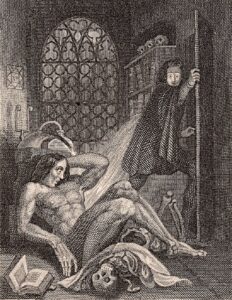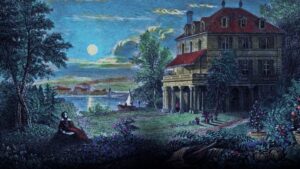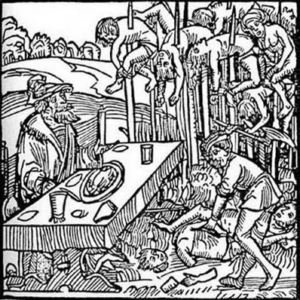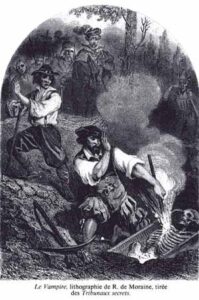
Illustration from the frontispiece of the revised edition of Frankenstein, published by Colburn and Bentley, London 1831.
Some of Hollywood’s most famous “monsters,” jumped off the pages of Gothic novels to the excitement and fear of spellbound readers. One of the most famous is the monster from Frankenstein. At the young age of just 18, Mary Shelley created a tale that would fill readers with dread, as well as empathy. Frankenstein, the Modern Prometheus, was a being imbued with humanity seeking love and acceptance. The teenage Mary Shelley created her tale during a ghost-story competition one stormy evening in the summer of 1816 while on holiday in Switzerland with Percy Shelley, Lord Byron, Claire Clairmont and John Polidori. During the course of her edits, the “monster” evolved from a “being” to a more human creature, and the book was first published in 1818.
As Mary Shelley’s horror story shaped Gothic literature, her copious notes and edits have been studied by historians, academics, and fans of the novel. The pages are now available online to viewers around the world on the Shelley–Godwin Archive. The original transcript is currently in the Bodleian Libraries at Oxford as part of the Abinger Collection. The collection was given to the university, in batches between 1974 and 1993, by James Scarlett, 8th Lord Abinger.
The Abinger papers are the residue of the collection of the Shelley family’s papers from Boscombe Manor (near Bournemouth, Dorset), the home of Sir Percy Florence Shelley, 3rd Baronet of Castle Goring (1819-1889), and his wife Jane, Lady Shelley (1820-1899). Sir Percy had inherited the family archive from his mother, Mary Shelley. She maintained papers from her parents, her husband, and from her own writing.

Villa Diodati, near Geneva, where literary character Frankenstein was created in 1816. (Credit: DeAgostini/Getty Images)
Since Mary Shelley had a close relationship with her daughter-in-law, it was Lady Shelley (Jane Shalley) who cared for and acquired additional items for the family archive. After her husband’s death, Lady Shelley endowed the Shelley Memorial at University College (1893) and she gave selected notebooks, letters and relics to the Bodleian Library (1893 and 1894). She bequeathed most of Mary Shelley’s other notebooks, relics, and papers to her husband’s cousin and the heir to his baronetcy, John Courtown Edward Shelley, later known Sir John Shelley-Rolls (1871-1951). Sir John gave the notebooks to the Bodleian Library in 1946.
Jane Shelley bequeathed her houses with their residual contents to her two eldest grandsons, Shelley and Robert Scarlett. Eventually, Shelley and Robert became respectively the 5th and 6th Barons Abinger, both childless. The majority of the papers were passed to their brother Hugh, the 7th Baron Abinger. When Hugh’s son James became the 8th Baron Abinger in 1943, he took a serious interest in the family papers. In the early 1970s, Lord Abinger gave permission for the Shelleys’ joint journal to be prepared for publication by Oxford University Press, and deposited the original journals at the Bodleian for the editors’ use. This led to Lord Abinger’s decision to provide the entire collection on long-term loan at the Bodleian in nine batches between 1974-1993.
Lord Abinger’s son James succeeded him in 2002. He put the papers on the market, but gave the right of first refusal to the Bodleian Library. The library launched a campaign to raise the funds. This mission was accomplished in 2004, when the Abinger collection was bought outright by the Bodleian Library with donations from the National Heritage Memorial Fund, the Carl and Lily Pforzheimer Foundation, and many other institutional and individual donors. Cataloguing of the papers was completed in 2010 with the aid of a grant from the John R. Murray Charitable Trust.
The information presented in this post can be found HERE.

Vlad Tepes dining while surrounded by the impaled bodies of his enemies; hence, the name “Vlad the Impaler.”
Another horror novel that has haunted generations of readers is Dracula. Inspired by tales of ruthless acts of violence and revenge exacted upon the Ottoman enemies of Vlad III (Vlad the Impaler, Vlad Tepes, or Vlad Dracula), Bram Stoker portrayed the Romanian ruler as a vampire and incorporated Romanian folklore about vampires in his novel. Written between 1890 and 1897, it is Stoker’s best known work. Count Dracula is one of the most filmed characters, and the tale has inspired countless other works, films, theatrical productions, and cultural references.
Nevertheless, the original manuscript had disappeared for decades. In a story worthy of the famous Gothic novel, the manuscript was lost and eventually found. In the 1980s, the heirs of Thomas Corwin Donaldson (a friend of both Bram Stoker and Walt Whitman) unearthed the manuscript of Dracula in a barn in Pennsylvania. Donaldson’s heirs sold the papers and manuscript through Peter Howard of Serendipity Books in Berkeley, California. Howard offered it to another book dealer and collector, John McLaughlin (owner of The Book Sail in Orange County, California). McLaughlin’s 1984 catalog lists the manuscript. Due to financial concerns, in 2002, McLaughlin consigned the manuscript to auction at Christie’s in New York.
 The manuscript is complete with Stoker’s original handwritten title, The Un-Dead (Stoker changed the title only days before the publication in 1897). The manuscript failed to sell went it went to auction in 2002 at Christie’s in NY. It is signed or initialled by Stoker in many places and contains a different ending to the final one published in 1897, and it was expected to fetch £1m. Since it failed to reach its undisclosed reserve price, it did not sell at auction. However, the novel was later sold privately through Christie’s to Paul G. Allen, co-founder of Microsoft. Allen passed away in 2018, and the manuscript presumably remains in his estate.
The manuscript is complete with Stoker’s original handwritten title, The Un-Dead (Stoker changed the title only days before the publication in 1897). The manuscript failed to sell went it went to auction in 2002 at Christie’s in NY. It is signed or initialled by Stoker in many places and contains a different ending to the final one published in 1897, and it was expected to fetch £1m. Since it failed to reach its undisclosed reserve price, it did not sell at auction. However, the novel was later sold privately through Christie’s to Paul G. Allen, co-founder of Microsoft. Allen passed away in 2018, and the manuscript presumably remains in his estate.